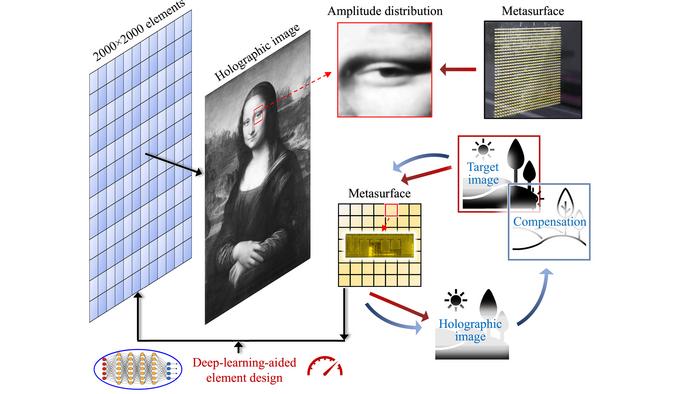WASHINGTON, May 30, 2023 – Holograms are often displayed in science fiction as colorful, life-sized projections. But what seems like the technology of the future is actually the technology of the present, and now it has been used to recreate the Mona Lisa.

Credit: Miao et al.
WASHINGTON, May 30, 2023 – Holograms are often displayed in science fiction as colorful, life-sized projections. But what seems like the technology of the future is actually the technology of the present, and now it has been used to recreate the Mona Lisa.
In Applied Physics Reviews, by AIP Publishing, researchers from Tianjin University, the Beijing Institute of Technology, Rowan University, the University of Missouri, Qingdao University, Shijiazhuang Tiedao University, and Beijing Jiaotong University developed an acoustic metasurface-based holography technique that uses a deep learning algorithm to generate and iteratively improve a hologram of the Mona Lisa.
Holograms are images created by recording and reconstructing the interference pattern of light or sound waves. They provide realistic and immersive visual or auditory experiences and can be applied in entertainment, medical imaging, and communication, among other fields.
Metasurfaces, or two-dimensional materials made of an array of tiny antenna-like components, can help a lot with the holography process.
“A metasurface-based hologram works by precisely controlling the phase and amplitude of the waves interacting with the metasurface,” said author Yue-Sheng Wang. “As a result, the outgoing waves at each pixel exhibit a certain amplitude and phase, which results in the desired holographic image based on their interference.”
The team wanted to develop a metasurface holography optimization method to enhance efficiency and precision. They used a deep neural network-based algorithm to customize the antenna-like structures within their metasurface. By iteratively reducing inconsistencies between the original and holographic image, they tweaked the metasurface and created a high-quality hologram.
“We chose to recreate the Mona Lisa as a proof of concept,” said Wang. “It is so famous that almost everyone knows about it. It is filled with countless delicate and subtle transitions of layers, which enhances the softness, haziness, and mystery of the painting. So it is a great way to demonstrate the effectiveness of our method.”
The holographic method successfully reconstructed the Mona Lisa, and, in even more detail, her left eye. While the Mona Lisa hologram is two-dimensional, the technique can be extended to create three-dimensional images as well.
“The precise control of sound waves offered by our holography method is crucial for advancing non-invasive medical therapies, effective noise control, and optimizing acoustic environments like concert halls,” said Wang. “These improvements have the potential to enhance quality of life and various technological applications.”
The authors believe their technique could revolutionize the field of holography. They plan to explore ways to generalize it, make it compatible with 3D printing, and reduce training time.
###
The article, “Deep-Learning-Aided Metasurface Design for Megapixel Acoustic Hologram,” is authored by Xuan-Bo Miao, Hao-Wen Dong, Sheng-Dong Zhao, Shi-Wang Fan, Guoliang Huang, Chen Shen, and Yue-Sheng Wang. It will appear in Applied Physics Reviews on May 30, 2023 (DOI: 10.1063/5.0136802). After that date, it can be accessed at https://doi.org/10.1063/5.0136802.
ABOUT THE JOURNAL
Applied Physics Reviews features articles on significant and current topics in experimental or theoretical research in applied physics, or in applications of physics to other branches of science and engineering. The journal publishes both original research on pioneering studies of broad interest to the applied physics community, and reviews on established or emerging areas of applied physics. See https://aip.scitation.org/journal/are.
Journal
Applied Physics Reviews
DOI
10.1063/5.0136802
Method of Research
Experimental study
Subject of Research
Not applicable
Article Title
Deep-Learning-Aided Metasurface Design for Megapixel Acoustic Hologram
Article Publication Date
30-May-2023




